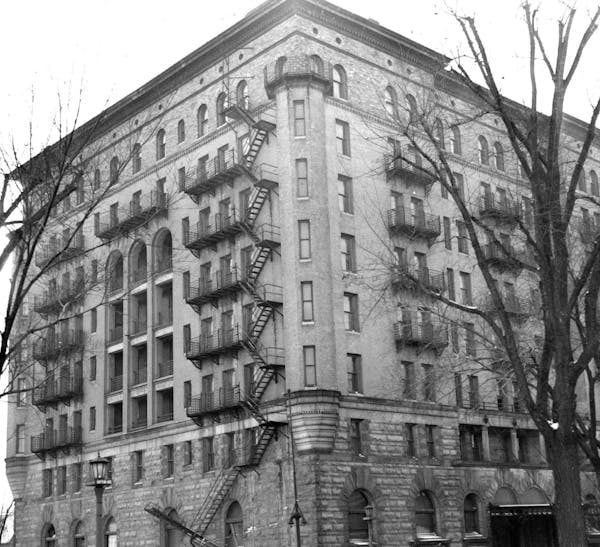A group of kids are kicking a soccer ball around on a nearby field as Carrie Hatler approaches a boarded-up building at Fort Snelling. She moves in fits and starts, pausing to study the best angle to shoot a photo, to peek through the cracks in the weather-beaten boards.
"I'm like that annoying person on the road that you're behind, and I'm going slow looking at stuff," she said. She pauses. Her deep-set blue eyes scan the dilapidated building. "I just really wish they would do something with these buildings. They're just sitting there."
Hatler, of Coon Rapids, isn't proposing a rehab project for the historic fort, some of which is now in ruins. But she is doing something.
She's writing about the fort and the people who once inhabited it, as part of a series for her website, Forgotten Minnesota (www.forgottenminnesota.com).
Her site, launched in 2011, features far more than tales of the fort — it gives accounts of everything from statues in Minneapolis' Tangletown neighborhood to the legend of John Beargrease on the North Shore.
"I like to think of myself as a historical tourist," said Hatler. To gather enough information for her weekly posts, she often starts by reading, then doing research about a particular place in a historical library. If she can, she visits each site, snapping photos, talking to passersby. In summer, she typically makes four or five outstate treks. Her goal: "to get people interested in going to these places and checking them out for themselves."
Before Hatley ever stepped into a history classroom, she was intrigued by the stories behind the "dates and places."
At age 5, when her family was headed to its cabin near Akeley, Minn., she spotted an abandoned pioneer cabin and asked her parents to stop.
"It was an old wooden shack off in the brush and surrounded by lilacs," said Sheila Hatler, Carrie's mother.
She wanted to explore it. Her family thought she just liked the flowers. "We never realized she had an interest [in its history]," her mom said.
As Hatler got a little older, her passion for the people behind the places was piqued. On trips through Duluth, she always insisted on stopping at the Glensheen mansion, site of Minnesota's most notorious murder, of heiress Elisabeth Congdon and her nurse in 1977.
It seemed she couldn't get enough of the past — in everyday life, on TV, in tales.
"We'd also drive through the older neighborhoods really slow so she could look at old houses and think about who lived there," said her mother.
That's the kind of curiosity that Hatler, 37, tries to bring to her posts.
"People are what make a building something more than just a pile of bricks," she said. "So thinking about the people that lived or worked at a certain place, or the people who built it, has always been the way for me to connect to the history of the place."
Engrossed in history
That connection is what has made the site popular — it regularly draws almost 300 visits a day and has scored fans among people who have made history their living.
Patrick Coleman, the Minnesota Historical Society's longtime acquisitions librarian, is one of them.
"I like the quirky and episodic nature of it," he said. "You have to have a certain attitude, a certain affinity to keep an eye out for these kinds of stories."
Beth Rutledge, education coordinator for the Preservation Alliance of Minnesota, said Hatler "does a beautiful job of personalizing history. … It is just great to discover, in words and pictures, the people and buildings that once made Minneapolis sparkle."
She added that Hatler is part of a younger generation that "realizes there's so much about our past that's worth celebrating."
Local author Larry Millett, best known for his "Lost Twin Cities" book and documentaries, said he was pleased that Hatler has made the history of loss "a topic of continuing interest."
"It's a fun way for people to get a sense of what's here and gone — lost places, lost stories, lost communities," he said. "And it's being done by people who are far more computer-literate than I am, so thank God for that."
While Coleman notes that Hatler's work is not historical research in the academic sense, it is "really snippets of interesting stories, but it doesn't try to tie it all together with something significant. But that's OK with me. It's not trying to be a work of scholarship."
Even so, Hatler puts in plenty of library time. She said she spends hours poring over papers and photos at the Minnesota History Center, the University of Minnesota's Andersen Library and historical societies in small towns. While she does some research online, she favors "obscure stuff that you can't find a thousand pages about on the Internet."
Of course, the Internet is the vehicle for sharing her work. Her site's array of articles is accessible via a sleek, engaging design. Hatler has a degree in graphic design, but is going back to college to study historical preservation.
In the meantime, she's out there on the prowl. Recent discoveries include an old mansion near the State Capitol and a ghost town on the North Shore, near Taconite Harbor. But this member of the Daughters of the American Revolution is always on the lookout for more, and she finds a story almost everywhere she goes.
"I have found," she said, "that word of mouth is the best way to find hidden gems."
Bill Ward • 612-673-7643
Follow Bill Ward on Twitter: @billward4
Ukrainian duo heads to the Eurovision Song Contest with a message: We're still here
With 'Alien' back in theaters, 'Alien: Romulus' director teases how the new film connects
Here's why Harvey Weinstein's New York rape conviction was tossed and what happens next

